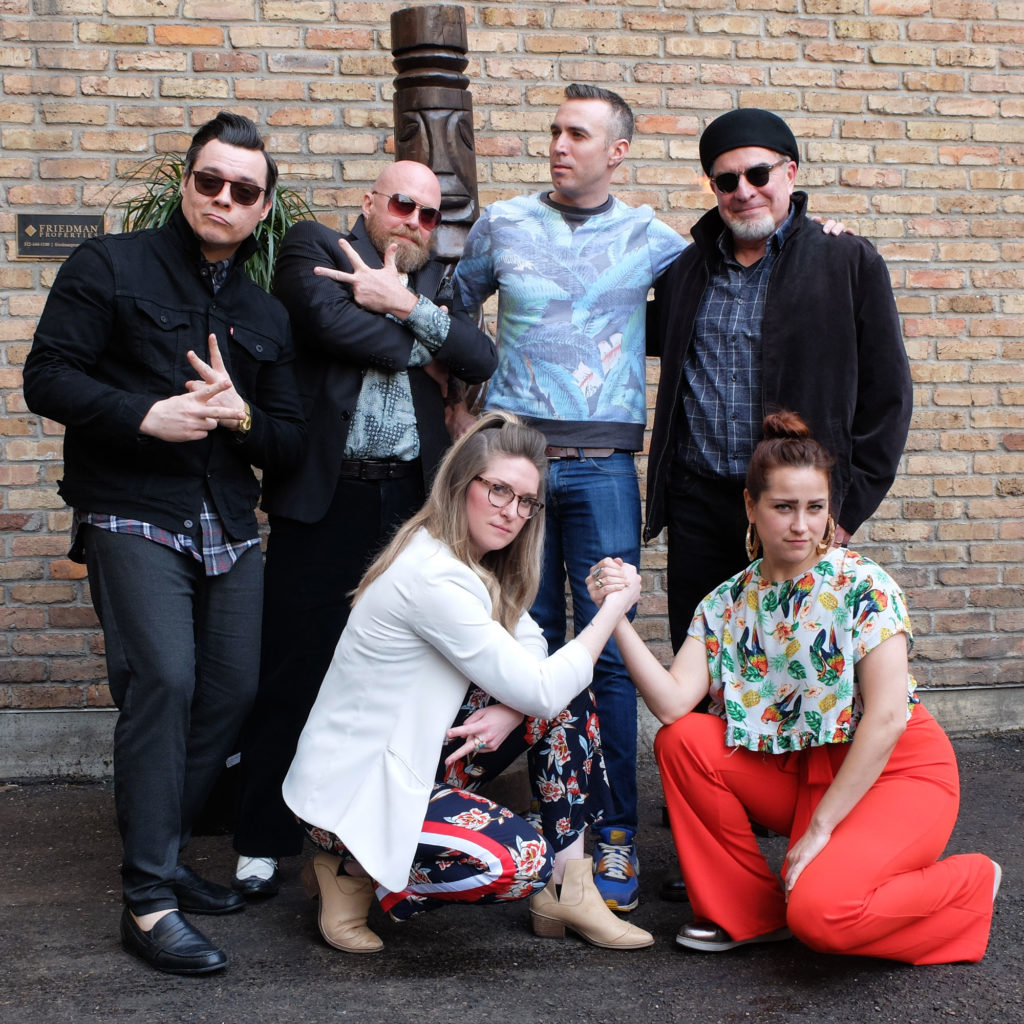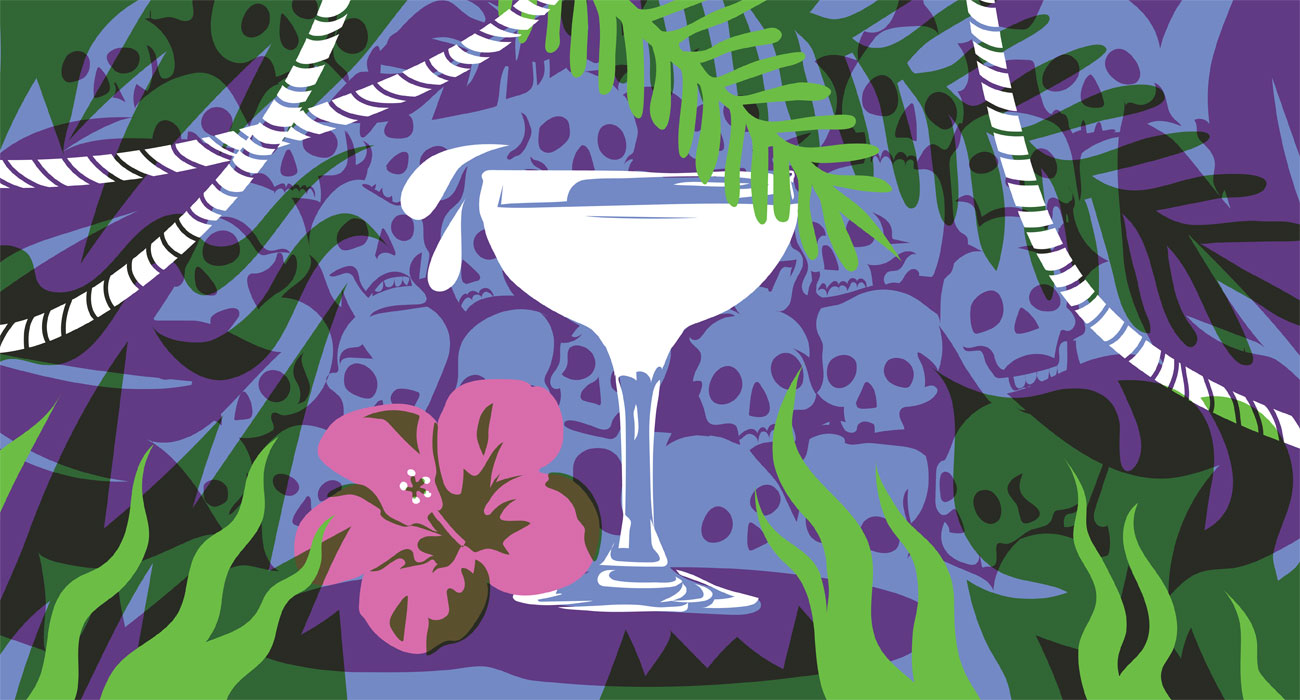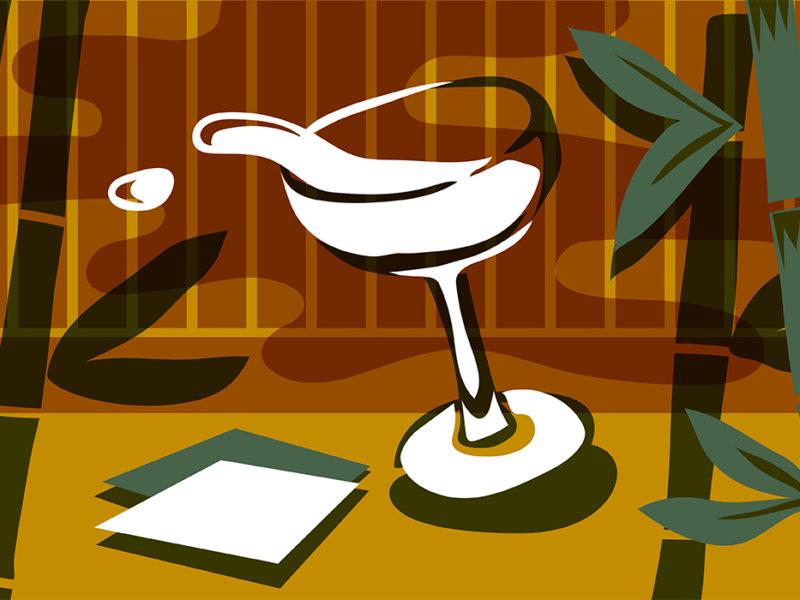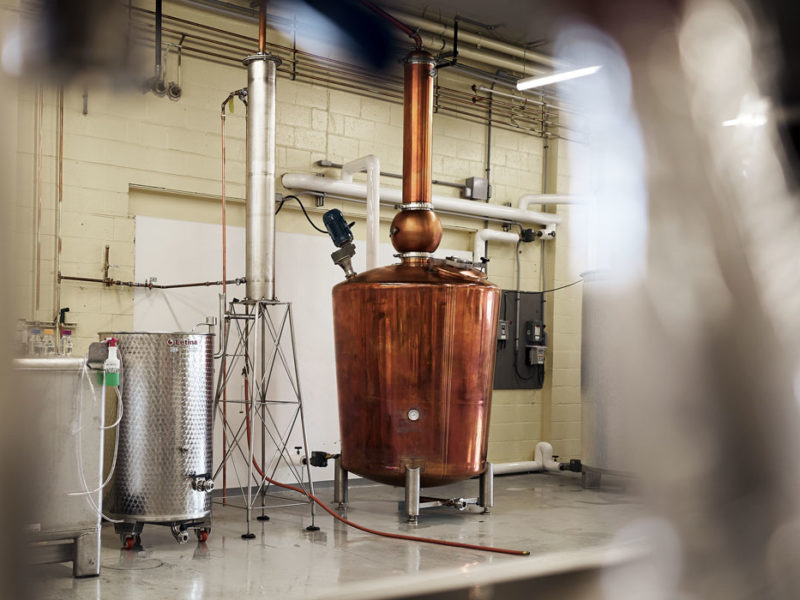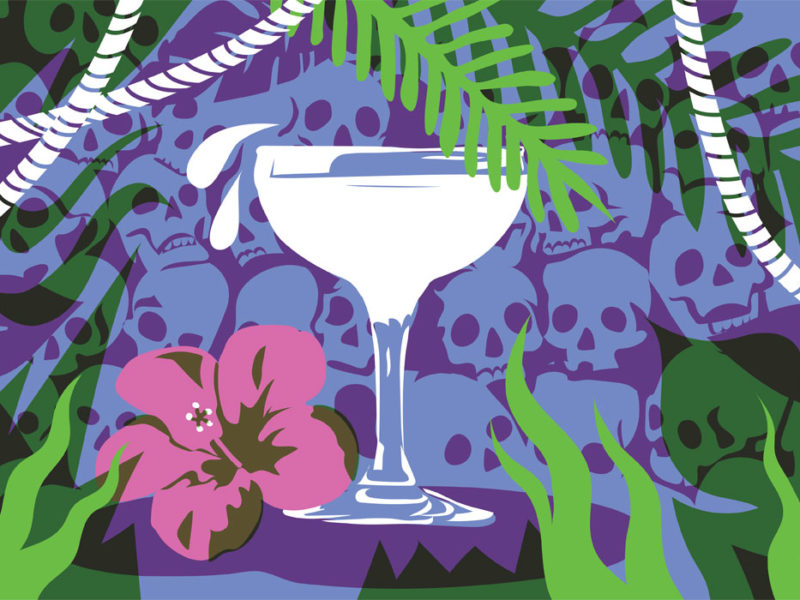These Daiquiri Symposia are becoming a “thing.” We have sat down with bibulous boffins at Death & Co. in New York and Manolito in New Orleans. Each time the conversation was unique. We knew we had to keep exploring. Now, we offer our third outing, to Chicago’s own Three Dots and a Dash.
On April 28, 2019, we braved a snowstorm (yes! really!) to convene at the au courant tiki den with the town’s top rumslingers. For the first time, we opened proceedings to the public, who were able to ask their soul-searching questions of the panel.
David Hammond ably performed moderating duties. David is dining and drinking editor for Newcity Chicago and a prolific contributor of food/beverage and travel articles for publications in Chicago and nationwide.
Kevin Beary was our host at Three Dots and a Dash, known for its combination of classic and innovative tiki drinks, where he serves as beverage director. He was named Chicago’s Rising Star Mixologist in 2018 by StarChefs.
Carley Gaskin is the co-founder of Hospitality 201, a Chicago-based catering, events, and consulting agency.
Toby Maloney is well known to cocktailians from his stints at Milk & Honey, Flatiron Lounge, Freemans, and Pegu Club. He oversees the drinks at The Violet Hour in Chicago, which won a James Beard Award for its outstanding cocktail program.
Adrienne Stoner started out at age twelve doing dishes at her mother’s job and is now the Chicago on-premise manager for Maison Ferrand, with years of tiki bartending under her belt in between.
Lee Zaremba is the beverage director of Boka Restaurant Group, where he is known for culinary-based cocktails with a playful personality. He otherwise spends his time studying jiu jitsu and hosting dance parties at home.
The bar team of Jon Chang and Scott Kittsmiller produced samples of all the panelists’ special Daiquiri specs for the assembled, for which we have much gratitude.
This transcript has been edited for length and clarity. — Ed.
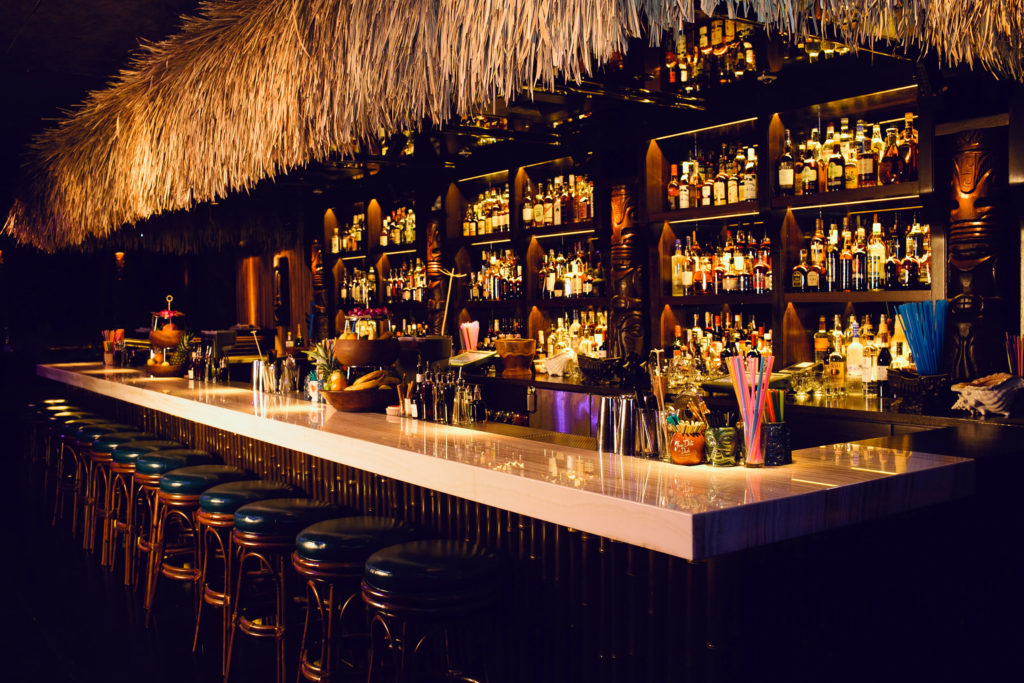
Three Ingredients and the Truth
David: So, there’s a million ways to fuck up a Daiquiri.
Toby: Dozens of ways to make it delicious and a million ways to fuck it up. The way I see it most often is the mixologist with the wonderfully twilled mustache and his cute-as-hell shake shaking the living shit out of it, and it’s over-watered.
Adrienne: Oftentimes, the proof of the spirit isn’t taken into consideration, so the drink is a little off balance. Maybe your equal parts lime and sugar take over and it’s like a dirty limeade.
Kevin: I think we’ve all been to a sketchy hotel bar or maybe an airport bar.
Adrienne: We don’t know what you’re talking about. Airport bar, tell me more.
Kevin: Maybe that’s just me. And you order a fresh lime Daiquiri and you proceed to watch the bartender grab some garnish limes and squeeze them into his shaker tin.
Carley: Right, or a Rose’s lime juice Daiquiri.
Lee: I would say the standard “I don’t give an F about you” shake is where people are like [mimes doing hardly anything]—“Here.” Air is one of the more important ingredients of a Daiquiri in terms of it feeling light and fluffy, getting that aeration into the tin, so that when you put it down, it’s got a nice crema, it’s easy to drink. For me, that’s one of the more enjoyable aspects. So, people fuck that up pretty regularly too.
David: So that’s an illegitimate Daiquiri. What must a drink have to legitimately be called a Daiquiri?
Toby: A Daiquiri is three ingredients and the truth. I think one of the coolest things about the Daiquiri is, at least in the beginning of your Daiquiri world, if somebody’s like, “I’m going to make you a Daiquiri,” you picture something that’s big and screaming red and has whipped cream on top, and that you’re going to black out and wander down Bourbon Street—but what you get is this small, bright, crisp, delightful Daiquiri.
Carley: I mean, listen. I’ve had my fair share of the Bourbon Street frozen Daiquiris. I think the very first Daiquiri I ever had was a strawberry Daiquiri covered in whipped cream. I was like, “This is amazing. I love mixology.” And since then—that was some years ago obviously—it has changed a little bit. If somebody makes me a Rose’s lime juice Daiquiri, I might shoot it rather than sip it but I’d rather have one to sip.
David: Since now it’s been brought up, how do you feel about frozen Daiquiris?
Adrienne: I will drink anything frozen. I am a trash human. There are ways to do frozen that aren’t so harmful. There are frappés. It has to be fresh ingredients. At Lost Lake, we always do a little grate of lime in our frappés, in a blender. You cut down some of the fresh juice and then mix in some of the grated lime. You still have that bright citrus and you don’t have something that’s going to turn into a watery mess after sitting for five minutes. But I will never knock a frozen Daiquiri, either blended or from a Frosty machine.
David: Any time of the year?
Adrienne: In Chicago? Yeah. As long as there’s no windows.
David: Yeah, we live in a rare city where you can experience all four seasons in a twenty-four hour period. You can actually do back to back tastings and see what climate it’s better in.
Kevin: We have many Daiquiris on the menu here, different forms, different iterations and interpretations of them. For one, we’ll take a Daiquiri and pour it over pineapple shaved snow. We totally recognize that that is not traditional, but it is delicious. So you’ve kind of got to ask yourself, “Where do you draw the line?”
Lee: I’ll be the villain here. I hate frozen drinks. I just don’t like to drink them. I like them in theory. In theory, they’re awesome, and I’m like, “Yeah, it should be colder and it should have more volume and it’s incredible,” and I never really liked them. The only one that I’ve ever thought was amazing was the Tic Tac Taxi [from Lost Lake]. I can rip those, but outside of that, I can’t do it.
David: Adrienne, you had said that you prefer drinking Daiquiris when it’s cold outside.
Adrienne: I’m born and raised in cold places. I’ve been in Chicago for eighteen years. I grew up in Milwaukee, so I’m used to being around a lot of cold weather. And I’ve also spent the majority of my adult life working in places with no windows and sometimes in basements. You need brightness and you need to have something to brighten your day.
It doesn’t make me feel any better to do multiple shots and drink really heavy cocktails and boozy stirred. I work on my feet all day, I work a hard job, and bartending in dark places makes you want a little bit of sunshine. And if that means I’m getting it in a Daiquiri, then that’s the quickest way. That’s how I’ve gotten into tropical in general. I’ve been into tiki since I was—I don’t know. My sister is here. How long has it been?
Adrienne’s Sister: At least twenty years. Thirty years?
Adrienne: At least ten years. I was in rockabilly band in my early twenties, and rockabilly and tiki go pretty tightly hand in hand. I lucked out when craft started getting interested in tiki again, so I could actually work at a good bar as well as do the tiki thing. So I’ve always been looking for brightness.
Carley: I agree with Adrienne wholeheartedly. I come from the South. I’ve lived in Chicago for almost three years now. The winters here, they don’t end and it blows my mind. Like it just snowed yesterday [in April]. And that’s insane to me.
Adrienne: I had a Daiquiri yesterday.
Carley: Right. I had a Daiquiri yesterday as well.
Adrienne: You sure did.
Daiquiri by Toby Maloney
Two, three quarter, three quarter. I like to split base my Daiquiris. A little agricole or Batavia arrack makes ’em sing, a rich JM expression in the spring. And a spritz of coconut bitters on top gets this classic motor running.
My favorite thing about the Daiquiri is it’s as perfect on a cold-as-fuck night in February as it is on a boat off the coast of a Caribbean island.
House Rules
David: Kevin’s rule of three is one of the more unusual commandments. Could you tell us about your rule of three for the Daiquiri?
Kevin: There’s a few things that apply in threes, in my mind, to Daiquiris. This is a personal preference thing, I don’t think that this should apply to everybody’s Daiquiris, but for me a Daiquiri has three rums.
You should be able to drink that Daiquiri in three sips. That’s not to say that you have to slam every Daiquiri you drink, but the aim of the balance of your rum, lime juice, and sugar should be at a point where it can be a cocktail that can be consumed very quickly without too much of a bite, without being over sour, without being too sweet.
And then in addition to that, I think it should be crafted in a way that you’d want to drink three of them, that you don’t drink one and then it’s overwhelming. But you’re going to go back for more.
Carley, I’ve heard that you’re one to order two Daiquiris at once.
Carley: Yes. It’s called the Double Daq. You order two Daiquiris. One to sip and one to shoot.
David: Kevin, I’m wondering to what extent the tiki environment, which tends to use many ingredients in cocktails, influenced your decision to make a three-rum Daiquiri?
Kevin: I think potentially. It’s something that I talk about called the sledgehammer or the scalpel. There are rums that are sledgehammers. Something like Wray and Nephew or an overproof Martinique rhum agricole or some blended rums. And then there are scalpel rums that are a little bit more delicate and more nuanced. When you have a wide selection of rums, you can use them more delicately to achieve your end goal, instead of really overpowering with one particular style.
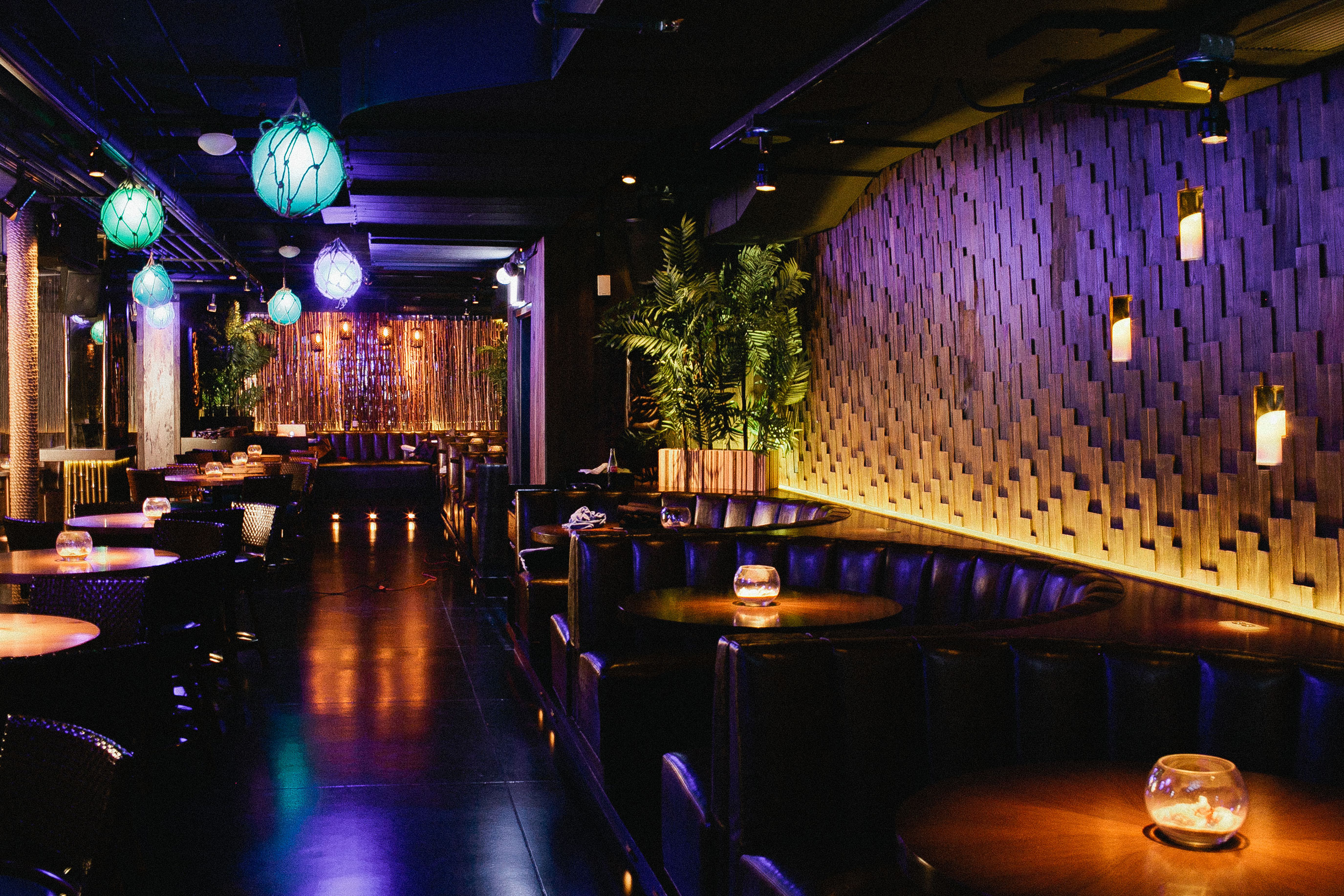
The Debate on Juice
David: Let’s start to deconstruct the Daiquiri. How do you use limes? Do you all hand squeeze?
Carley: Hand squeezing is amazing. You’re getting the freshest, freshest lime juice. Since I run an events company, we’re making hundreds and hundreds of Daiquiris at a time. It’s impossible to hand squeeze every drink, but we will juice limes hours before the events, and the lime juice is really, really fresh. I think you need really, really, really nice, bright lime juice to really make that Daiquiri perfect.
Kevin: I think there’s a lot of debate on juice. I don’t think anybody touched on how long you should let lime juice oxidize before you make Daiquiris. Bartenders, especially European and American bartenders, are always the ones that are having that rift. European bartenders like to juice their limes just before service and American bartenders prefer to allow their lime juice to oxidize for a few hours before they use it.
In my opinion, I think that’s a bit over-analyzed. I think that your lime juice is always going to be varied from day to day. The important thing is tasting your Daiquiri and making sure it’s balanced, and then making the necessary adjustment, either for more sugar or more acid, to get it to what you think is the perfect balance. It shouldn’t be too focused on the hours, minutes, and seconds that the lime juice has been oxidizing.
David: Is there some value in oxidation in that case?
Kevin: A lot of people say that the lime juice becomes a little bit more gentle, gets a little bit more of a limey flavor.
Lee: I don’t have a lot to say about this, to be honest with you, but the one thing that I do appreciate that is different, especially in Daiquiri production, is shaking with a piece of lime in the shaker. Releasing all those oils and aromatics, making it a little bit more limey, that little buzz that you get on your lips and your tongue from that lime oil. That’s a variation that I really enjoy at times. I think you have to account for it and build on it, but that’s the unknown quantity that almost nobody talks about.
David: Do you find that adds a bitterness to it, is that what you’re going for?
Lee: I don’t think it adds a bitterness so much. I think the general lime variation will create a sense of bitterness depending on where the limes are from and how fresh they are. Was the lime super pulpy and super pithy? Because that juice will be much more bitter. It really depends.
I went to Peru recently and the limes are so different in Peru. There’s almost no bitterness. The cocktails were so different that I had a hard time trying to bring that same spirit of cocktailing to our menus with what we have available. But making adjustments and adding lime oil really helped.
David: Do you experiment with makrut limes, Key limes, or other types of limes?
Lee: I would say a lot of my experimentation has been limited to cost analysis. All of those other limes are expensive. And to get the amount of them that we would need to be able to propel a Three Dots and a Dash or a Cabra rooftop, it’s an incredible amount of product to get in and it’s just not sustainable.
I was experimenting with finger lime tinctures and things like that, other ways to get lime flavor into cocktails, especially with gin and rum combination cocktails, and stuff with heavier ingredients like orgeat where you can inject a sense of lime.
Carley: I think there is something to be said about using different citric acids, malic acids. I know, Kevin, you did a really cool one and I’m still just mind-blown about it. It was a clarified Daiquiri. It was citric acid, a little simple syrup, and rum?
Kevin: Yeah, citric acid, malic acid, and succinic acid in the same pH as lime juice, which from a sensory perspective does very much make the connection in your head of being lime juice and representing that acid, but doesn’t quite have the lime flavor. I think it’s an interesting part of the conversation, but I’ll never say that a simulated acid Daiquiri would ever be as good as a fresh lime Daiquiri.
Daiquiri by Kevin Beary
I feel that Daiquiris are one of the most universally appropriate rum cocktails. There are few times I am not inclined to partake in a well-made Daiquiri. Daiquiris are a function of the rums used to compose them. It is impossible to make a good Daiquiri with bad rum and my perfect Daiquiri depends on what I am in the mood for. Sometimes it is a green and grassy blend of rhum agricole blanc and other times it is the funk of the long-fermented, pot-distilled, high-ester Jamaican rums. If I had to single out one build, however, it would be the following spec:
¾ ounce aged or unaged Martinique rhum agricole
¾ ounce high-ester Jamaican rum
½ ounce Cuban-style aged rum
1 ounce lime juice
½ ounce Martinique cane syrup
On a distillery visit in Venezuela, some fellow bartenders and I decided on the Rule of Three for Daiquiris.
1. It should have at least three rums.
2. You should be able to finish in three sips.
3. You should be able to drink three of them.
In regards to location: Sitting in the sand at La Cabane Beach bar in Batts Rock Beach, Barbados, with a split base Foursquare 2004 and Rum-Bar Overproof Daiquiri.
Sweetening the Mix
David: How about sweeteners? Granulated sugar was perhaps the original ingredient. Do you have a preference for simple syrup, or other types of sweeteners?
Toby: I would guess that the closest thing to what was used originally would be cane syrup. It was what was used in Cuba at that time. We use simple syrup one to one because it is the cleanest, straightest way to make the other two things sing. But in the winter, a Daiquiri split base with white rum and dark rum and a little bit of Dem, that’s going to be delicious as well.
Carley: I think the Daiquiri depends on the sugar. You have so many different types of sugar but it’s still sugar. So you’ve got Demerara, you’ve got cane sugar, you’ve got a simple syrup. When you start using different sweeteners or modifiers like honey or maybe a sweet cordial of some type, to me, that’s not really a Daiquiri anymore. It has to be a kind of sugar whether that’s powdered sugar, one to one simple, two to one simple, Demerara, cane, I can go on for ages.
Adrienne: I typically prefer cane syrup. I like the weight. I like the mouth feel. It has a little bit of depth to it. But I would also say that if I’m using a very kind of light rum, it would be overpowering. I don’t normally drink Daiquiris with very light rum.
Kevin: Yeah, I’m kind of a snob about it. I think Martinique cane syrup is the best way to make Daiquiris. It’s 72% sugar. It’s some of the richest syrup you can get. Any opportunity for me to limit the amount of additional water that’s going into a cocktail, I’ll generally go in that direction. And as some of you mentioned, for sure, it’s the mouth feel of the Daiquiri. Nice, thick, rich syrup is going to give you a good mouth feel.
However, we now have to think about how irresponsible it is to ship cane syrup all the way from the Caribbean just to make cocktails with it. It’s expensive, there’s a ton of packaging, a ton of shipping. It is not the most sound environmental choice.
Lee: I feel like the one thing everyone’s kind of hinting at up here, that not everybody in the crowd may be aware of, is that every different style of sugar that exists in the world has a different flavor. Different sugars really impact the flavor and overall profile of a drink even if we’re using the same rum and the same lime. If you switch up that sugar it really, really changes the outcome of the cocktail: how you perceive the flavors of the alcohol, what bite the citrus has, which is a compelling factor.
They Like Rum
David: Is there a rum that you prefer to use?
Toby: The closest at hand. You can make a good Daiquiri out of any rum. You have to understand the properties of that rum, the properties of your sweetener, the properties of your lime juice. Taste it before you pour it into the glass, actually think about it for a hot second. Then if it needs another dash of lime juice, another dash of sweetener, one or two more shakes to get the water content right, then you have a Daiquiri. You can make it with any rum, you just have to understand it.
Carley: Yeah, I one hundred percent agree with Toby on that one. When using a dark rum, for example, I might go with a darker type of syrup, maybe Demerara. If I’m doing a white rum, I’m probably going to stick with the cane sugar or simple syrup to pair those. There’s a lot of rums where if I’m making a Daiquiri I’ll add a little bit of saline. There’s a lot of rums where I’ll make a Daiquiri a little sweeter than I would normally, or use a quarter ounce of lime juice and a quarter ounce of simple syrup. You build it around what rum you’re using and the rums you love.
Adrienne: I agree.
Kevin: I think a Daiquiri is a function of the rum you use to make it. It’s virtually impossible to make a good Daiquiri with bad rum. I think that’s what makes a Daiquiri such an iconic and interesting cocktail and such a good platform. It is the blank canvas to showcase different styles of rum. It is simply all about the rum.
If you have to make a Daiquiri with one rum, at that point you’re limited to one particular character or style of rum, so that’s what you need to zero in on. If it’s going to be a single rum, maybe something more character-forward like Martinique rhum agricole, something a little bit funkier like high-ester Jamaican. But at that point, you have to make a more conscious choice for a particular style of Daiquiri instead of a more well-rounded Daiquiri.
Lee: What’s really amazing to me is going to [Chicago liquor superstore] Binny’s and going to the rum aisle, looking around, and you’re like, “Holy shit, there’s forty-five rums here.” We live in a unique and unparalleled time for access to different spirits and to different rums. You can choose random stuff off the shelf, have a small sip of it, get to know it.
Personally, I love rums in my Daiquiris that present a sense of place or terroir. I love what I would consider to be unrefined rums. Like aguardiente, which is a sugar cane distillate traditionally from South America. I love it because it’s funky and I think about those vegetal notes. That’s why I like Neisson and rhum agricole and all those different brands, because I feel like you taste a little bit of the earth, you taste a little bit of the plant. I’m super romantic and my imagination’s all fucking reckless, so I sit there and think about it like, “Is there some saline? Is this rum about the ocean?”
And that’s so much of the fun of drinking Daiquiris for me. It’s just nerding out and a bit of escape. You can pick your route of escape at the store, and it’s crazy to me how much we have to choose from.
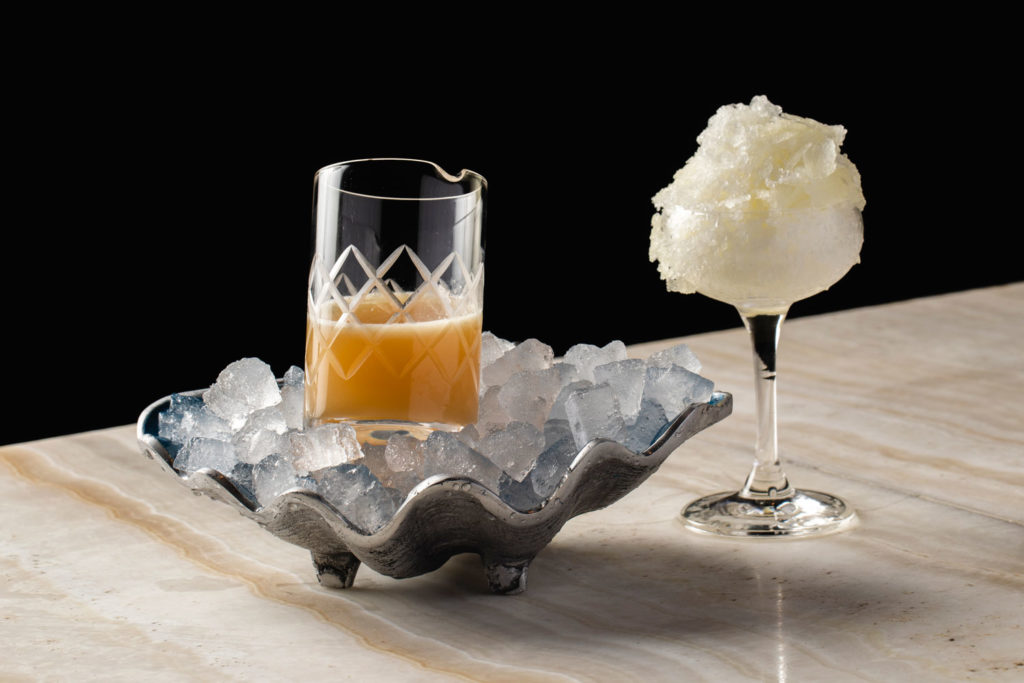
Ineffable Terroir
David: The question of terroir in rum, just like the question of terroir in any distilled spirit, is difficult to pinpoint. Some people feel that you can’t actually discern terroir in a spirit because all that flavor’s been stripped out in the distillation process. I don’t agree either, Kevin! Why do you not agree with that?
Kevin: I think because I’ve seen it. I’ve tasted rhum agricoles produced from fresh cane juice growing from this part of their plantation and this part of their plantation and this part of their plantation, all fermented and distilled in exactly the same way, and they taste different. The only variable was the difference in the cane, so I think that is truly the definition of terroir. So while I agree that it’s a difficult statement to make about distillation and terroir, I think there are rums—not all rums—that are incredible examples of it.
David: I think when you’re dealing with rums that were distilled from molasses rather than sugar cane juice, terroir is difficult to determine. You can take that molasses from anywhere and distill it anywhere, so it’s kind of difficult to determine what place is reflected.
Kevin: There’s a lot of cultural influence on the way they treat that molasses during fermentation that affects the qualities of the end rum. I think in some ways that cultural influence takes the place of terroir in determining why a rum tastes the way it does when it’s made in a certain place, even with molasses.
Toby: And terroir, it literally means of the earth, but it also means the yeast that are helping it ferment, and the air, and how close it is to the mountains, for example. While I would say that agricole oftentimes is a cleaner spirit, I will be the villain here. I’m still learning to like agricole. I spent a month in Martinique drinking it every day—taking one for the team.
And I learned some things. Agricole and honey makes all the sense in the world and I can really, truly enjoy agricole and honey together because they make sense in my head. But agricole is still a little petrol-y for me. I enjoy it and I can appreciate it but it’s a little too much. Sorry.
Adrienne: I used to work for an agricole company, and I’m obsessed. I still love agricole, but I think when I first found out about rhum agricole back in the day, I learned how experiential rum is. I found that was different than my experience learning about whiskey and beer. Rum has this way of transporting people, and we’ve mentioned that multiple times on this panel. It doesn’t mean that I’m on vacation all the time.
I used to always drink Rhum JM Gold straight as my shift drink, when I didn’t want to bother my bartender friends to make me a drink, but it’s such a pleasant memory now. One sip of that rum and I’m immediately relaxed. You have those pleasant, positive triggers associated with rum in a way that I don’t get from a lot of other spirits. I think it’s a little bit of a magic spirit that way.
Carley: And terroir aside, there are so many variables that go into the production of rum. There’s column stills, pot stills. Are you filtering after you’re barreling? Sugar types. But it is cool to taste the different terroirs and the regions. There are some really distinct flavor differences.
Kevin: I will make one comment on that. Like you were saying, it’s this incredible diversity that makes the rum category so interesting. Rums like Martinique rhum agricole are one of the pillars that make you understand that. This is rum, but Bacardí’s also rum, and these two products could not be any more different from one another, but are in the same spirits category.
Rum’s a spirit that is produced in a vast region all across the Caribbean, South America, many, many places. When you compare it to other spirits categories like Cognac or Scotch whisky or even bourbon, these areas have created regulations in order to protect their product and ensure quality.
We’re now starting to see that happen in the rum industry, most recently with the creation of GIs [geographical indications] in Barbados and Jamaica, following along the lines of regulation in Martinique for rhum agricole. These are all protections that in the long term are going to create quality rums and really ensure that these regions are reaping all the benefits of creating spirits that should be protected.
It’ll be a situation where if you want to label your rum as rum from Jamaica, it will have to meet a set of criteria that ensure that it’s a quality rum product. You can still make rum there and sell it as rum, you just won’t be able to advertise it as a rum of Jamaica, as an example.
Adrienne: But unfortunately, the TTB [United States Alcohol and Tobacco Tax and Trade Bureau] doesn’t follow those GIs. And the U.S. has notoriously the most loose TTB requirements. You can pretty much label anything as rum and sell it, and no one cares. They can call it rum even though it’s not even full proof. You get into this war of trying to be recognized for your craft. Each island has every right to come up with their rules and how they want to be treated and how they want to be respected with their spirit.
That’s a change that’s coming with the GI in both Jamaica and the one that’s coming for the first time ever in Barbados, but it won’t include molasses. The sourcing for molasses won’t be regulated in any way. So that’s kind of a weird extra thing that in other countries like Scotland and the AOC for Cognac, certainly, are heavily regulated. So these GIs are a little bit different. It doesn’t work exactly like those other spirits do. But yeah, there’s nothing wrong with adding a little bit of ownership to your land that way.
Rum can come through your store really cheap. And in America, if you see a bottle of spirit that costs less than $20, your assumption is that it’s crap. Whereas you see really expensive whiskey bottles and the general consumer has price shock and they’re like, “Wow, that must be really good.” Whether it’s good or not is a whole other story, but in addition to GIs, rum will see things start to be priced accordingly, and we can start putting more effort into making that rum and qualifying it by price as well as in talks like this.
Toby: Terroir is cool if you are sitting at a bar and your palate is really amazing and you’re drinking some really old thing by itself. All of that goes out the window as soon as you put a quarter of an ounce of lime juice in there. I’ve always said that I would much rather have a Jack and Coke made by a happy bartender than a Hemingway Daiquiri with the grapefruit juice being squeezed by an angry mixologist.
So, terroir is one thing, but we talked a lot about these really small distilleries who are making it with love. And then these huge, massive people who are making a bunch of shit because they really don’t care, they just want to make money. So for me, terroir is more about the love of the land and the process than necessarily the exact type of vanilla you get out of that rock.
David: It almost seems that barreling would create defects. If you’re going for terroir, the taste of the place, then anything that interferes with that, could it be considered a defect? Something that gets in the way of your appreciation of the pure spirit from that place?
Lee: No, I don’t think anybody takes it to that level. I think when I say, “Oh, I like this because it’s funky,” I get a sense of place for this because it’s slightly vegetal. I’ve never been to Martinique. I’ve never sat on that corner of the beach and seen Todd who always brings in the sugar, and his sweat is brought into this room as well. It’s not like that. To Toby’s point, they’re minor differences. I appreciate your point about the terroir of the bar you’re drinking in. And it made me think of, “Oh, yeah, when I have a Miller Lite, I want to have peanuts on the floor and hockey on the TV.” That’s the terroir of Miller Lite for me.
Daiquiri by Adrienne Stoner
Ideal Daiquiri is a real hard question because it depends on so many other factors! Let’s try to dissect.
My favorite time to have a Daiquiri is cold weather. 100%. If it’s nice out I’ll pretty much drink anything because I’m a garbage person in the sun. Luckily for me, I live in a cold, dark, cloudy place like Chicago where I can enjoy ALL THE DAIQUIRIS! I generally enjoy unaged funky Daiquiris but sometimes I’ll go left field with an aged Saint Lucia or Jamaican. Really, I like so many rums that it’s very hard to nail down the best. My usual spec is 2/1/.75 with cane syrup. I tend to use drier rums for my Daiquiris and I appreciate the richness and weight of cane syrup. Obviously fresh lime. Shaking with half a lime brings an extra bright citrus touch but again…depends on the rum! Rum is experiential in a way that not all spirits are. Mood and placement are everything. How a sip of JM Gold reminds me of finishing a shift forever or Xaymaca reminds me of my first trip to Barbados (because we tasted it there first and a couple of us promptly killed the bottle). Or even Smith and Cross is forever my tenure at Three Dots because I tried to put it in EVERYTHING. Just a whiff of rum and I’m there. It’s crazy. Or maybe I’m alone in this….
We had a little thing called the “party boy” style Daiquiri at Lost Lake which was dubbed as such because our male bartender didn’t like the effort of double straining. Surprisingly, I quite enjoy a good old dirty dump Daq [dumping the shaker contents in a glass without straining] if we’re going full heat Wray Wray or funk and proof equivalents. When served this way, no straw, rocks glass, the more pedestrian the better. These are especially good for crowded bar nights, standing room only, might get bumped, trying to drink slow, marathon style Daq. Often these are my most magical experiences while avoiding snow/wind/traffic/politics/work and whatever else Chicago tries to break us with.
Another perfect day: People watching in another windowless lounge. I’m a fan of big band jazz, and if the Green Mill could ever make a decent Daq this could be a dream come true! Served in a vintage round coupe with a slightly longer stem (so as to elongate my tiny rat hands), pink rim to disguise lip marks and complement the green of the cocktail, bamboo shaped stem because I’m tacky and secretly an old lady. I wish I could try the J. Wray and Nephew 15 year though I’ve tasted the Plantation Collector’s edition made for Steve Remsberg and it was pretty delicious. Or the original Mai Tai 17 year?! Aim high right? I’ve had some pre-embargo Cuban rum and I think it’s just wasted on me. I’m just as happy with Don Pancho most days. I know, I know (boooo/hissssss)! Or maybe I can make a Daiquiri with the rum found at the Harewood House? I can’t say for sure that I’d like it because I’ve never tasted it.
Does this cover it? I can go on. And on.
Enter Becky
Lee: I think the idea that rum is made from sugar is sometimes misconstrued by people. This weekend, somebody came into the bar that I’m operating right now. And they were like, “I was looking at this cocktail, it looks boozy, I like that.” And I was like, “Yeah, it’s a great, slightly bitter, booze-forward rum cocktail.” And she looks at me dead in my face. And she goes, “Rum is made from sugar. It’s sweat.”
And I was like, “What? What did you just say?” And she’s like, “Are you deaf? It’s made from sugar. That’s why it’s sweat.” I was like, “Did you say sweet?”
And she was convinced. “Nope, not gonna have it.” We sent one to her table anyway, and she wouldn’t even touch it because she was like, “I don’t want a hangover, okay?” And I was like, “Well, you had some in-depth questions about what was one of the more interesting and complex cocktails on the menu. I just wanted you to try it.” But that was a misnomer on her part. “Oh, it’s made from sugar. It’s going to be sweet.” There are plenty of rums that are commercially available that are sweetened as well. And I think some of the general public still carries that stigma with them when they see rum or rum cocktails.
Adrienne: I was just going to say I loved your characterization. Of Becky slash Karen slash Carol. No offense to anybody with that name in this room.
Toby: I’ve been hearing “I want that drink, but not too sweet” for so many years now. I think there’s a couple of things that go into it. A drink, a good cocktail, has mouth feel. Mouth feel is when it sits in your mouth, it feels good. It’s not too boozy, too sticky sweet, or too sharp from the acid. And it’s really easy to go into that sweet because, out of all of those, that’s the easiest one. Finding ways to get a good mouth feel and a good texture out of a cocktail, using garnish and aromas and things like that, is of utmost importance, but I think it’s just lazy that it’s easier to fall into the sweet trap than it is into the boozy trap or the bright trap.
Yet they say, “I don’t like sweet,” and they drink Malibu and pineapple.
Adrienne: Actually, as a bartender who spent the last six to seven years bartending in rum bars, I find vodka drinks very challenging to make. And I think that when you’re working with a neutral spirit like vodka or even really, really light rums, that’s hard for me because the balance is more reliant on the modifiers. It’s modifiers versus proof and the spirit itself doesn’t lend that much character.
When I think about when I started bartending and drinks in the ’90s, yeah, all of those drinks were trash, because we were using really light spirits. We were using what we could easily get in our bars and stores which were super mass produced vodka and rum that didn’t have a lot of flavor—on purpose—because they were for a large, wide audience. We’re all sugar burned because our palates took a lot of battering back then. And we’re trying to work through that trauma.
Daiquiri by Carley Gaskin
My favorite Daiquiri riff that I’ve made is called the “Matcha Man” (OOOOOH YEAH!). This drink combines three of my favorite things. Matcha tea, the absurdity of pro wrestling and, of course, a good pun. This cocktail is the perfect balance of acidity, sweetness, and earthiness. The cacao comes through on the finish to perfectly marry the grassiness of the matcha tea with the brightness of the lime juice. Wray & Nephew comes through to give the cocktail a little kick in a true Randy Savage fashion.
Matcha Man
½ ounce rich matcha tea
1 ounce Caña Brava 3 Year Old Rum
½ ounce Wray & Nephew Overproof Rum
¾ ounce Marie Brizard White Creme De Cacao
¾ ounce lime juice
½ ounce simple syrup (1:1)
Shake over cubed ice. Serve in a coupe glass. Garnish with edible flowers or a Slim Jim.
Kevin: Can I ask the audience a question here? And there’s no judgment either way on this. Would you raise your hand if you thought the Daiquiris that you’ve tried today were sweet? Were those sweet drinks? Be completely honest here. I see half of them, right?
So the balance we’re talking about with Daiquiris here is the balance generally of an ounce of lime juice, or three quarters, to an equal part of a one to one white simple syrup. And that is the basis to which so many juice-containing cocktails are built. And I think that sort of where the dividing line is on sweet cocktails.
If you think that balance is sweet, then there’s going to be a whole world of cocktails you don’t like. If you’re comfortable with that balance, I would almost say the majority of tiki cocktails are built on that same balance. So I think that’s sort of an interesting feedback from you guys that if a Daiquiri is not a sweet drink, there’s this entire category of rum cocktails in most of the realm of tiki cocktails that are built in that same proportion. And therefore shouldn’t be considered sweet.
Carley: I’ve had the pleasure of working in every single type of bar. I worked in a sports bar, I worked in a nightclub, I’ve worked in a high volume craft bar, I’ve worked in restaurants. And one thing that I’ve noticed in my career of bartending is that people like what they like and that is okay. If Becky wants to come in and she wants her Tito’s and soda with a lemon, lime, grapefruit, orange slice, that’s totally fine. I’m happy to make that for you, Becky.
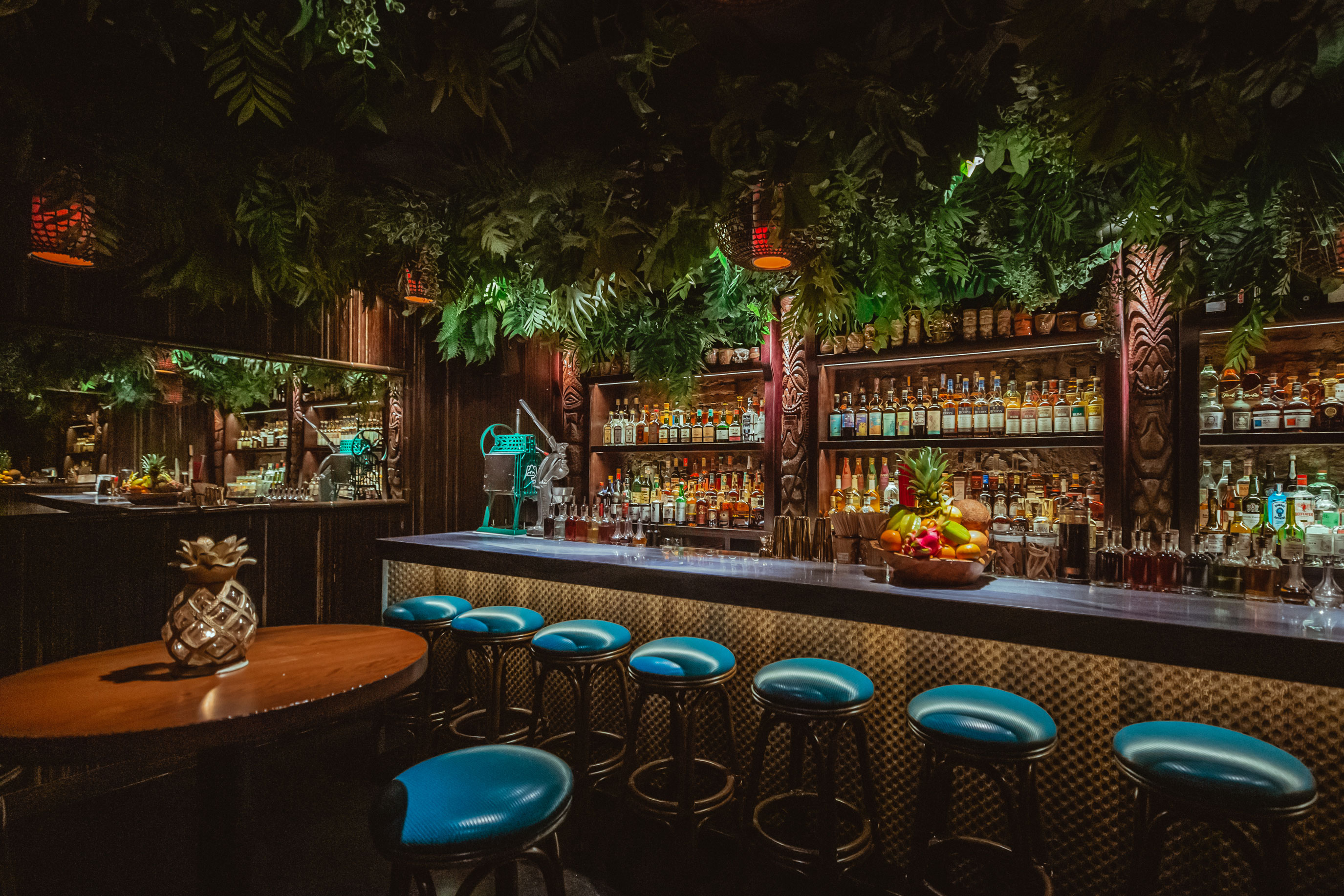
There Are Questions
David: Let’s open it up to questions.
First Questioner: Before I came in today, I stopped in at one of Chicago’s most high-end hotel bars and I had a Daiquiri. And I was really bummed out because it was pre-batched aside from the lime juice. So my question is, if you’re paying eighteen bucks for Daiquiri, should you say to the bartender, “Hey, I want to know what I’m drinking.” Or should I not be drinking a pre-batched Daiquiri at all?
Carley: You’re saying they pre-batched it without lime juice?
First Questioner: The lime juice was added and they shook it, but when I saw that, it just said Daiquiri on the bottle. It was the rums, pre-mixed. It really left a bad taste.
Carley: Did the Daiquiri leave a bad taste? Or did the pre-batching leave the bad taste?
First Questioner: Pre-batching.
Carley: How was the Daiquiri?
First Questioner: It was okay.
Kevin: Well, yeah, that’s a tricky one. So here’s the thing. It’s all about the care you put into it. Yes, you can take some crappy rums and maybe rums you’re not proud of, and you don’t want to show that label, and you can put it into a bottle and make Daiquiris with it.
But on the other side of the coin, you can make a very careful rum blend. Like I said, I don’t make Daiquiris with any less than three rums. At times that is prohibitive in how long it takes you to make the drink. So if efficiency is key, and you’re using good rums, and you batch them together carefully, and like you said, you don’t add the citrus in, I personally don’t see a problem with it. But transparency is important. Should you be making anybody a drink where you’re unwilling to tell them what base spirits you made it with? I don’t think so.
Adrienne: A little side note about bottles with no labels. In tiki specifically, that was strategic. If you go to a tiki bar and they intentionally leave the brands out, it’s for secrecy’s sake, it’s because we don’t want other people making our drinks, stealing our cocktail recipes, because that’s how it started. That’s how Trader Vic got a job, by stealing recipes. Water under the bridge, he ended up coming up with some fabulous recipes of his own, like the Mai Tai. But that’s kind of where that started. So Daiquiri aside, if you see that happening in tiki bars, politely acknowledge that it’s their private recipe, and it’s none of your business.
Carley: I’m coming from an events perspective and a catering perspective where I’m making hundreds or thousands of cocktails at a time. So hell yeah, I’m pre-batching all of that, but I put a lot of care into it. So like Kevin was just saying, you can have a delicious Daiquiri because you see the amount of effort and thought that goes into that rum blend, that goes into what type of sugar, that goes into whether or not they’re adding saline or not, and it goes back to how much anybody cares. And if they’re charging eighteen dollars for something, they should probably care.
David: Do you want to confess, Kevin, about the Daiquiris we’ve been drinking today?
Kevin: Yeah, so I made these Daiquiris on Tuesday. I’m joking. But we did put these Daiquiris together with the rum, the lime, the citrus about fifteen to twenty minutes before you arrived.
David: How were the drinks here today?
First Questioner: Awesome.
David: Right, so it can be done.
Adrienne: As you learn more about rum and as you become more of a steward, feel free to check the back bar and pick your own. Have that discussion with your bartender so that you don’t feel slighted by their choices. It clearly seems like it wasn’t your favorite Daiquiri. So find out what your fave is and then demand it.
Carley: Do your homework and taste a lot of Daiquiris.
Daiquiri by Lee Zaremba
Dream Daiquiri?! Oh man. For me it’s two ounces Neisson Agricole Blanc, three quarter ounce fresh lime juice with the lime half in the shaker, three quarter ounce simple syrup. All shaken on a beach right at sunset, the gentle ripple of the tide tickling the beach front. My feet are in the sand and I’m holding this ice cold Daiquiri on the rocks with the ice it was shaken with and the lime floating in it releasing all those oils. I take a deep breath in, waiting for dusk to fall upon us, truly relaxed.
I love a lot of funky and weird rum, but ideal settings include a tropical environment and a non-complicated, drinkable, and refreshing Daiquiri.
Second Questioner: I know you guys spoke a lot about lime juice and how important it was. I won’t lie, I am one of those people who says, “Oh, I don’t really like it that sweet.” And whatever the bartender serves me, I’ll just take it. Which is awesome, but I’d much rather prefer to be super direct and be, “I want this, this, and this in the drink.” And I know you guys touched on those three specific ingredients, but I’d like to cut out the ingredients that give you heartburn, and I know sometimes it’s the lime juice. So I’m curious what could I possibly substitute and be direct to get kind of a Daiquiri?
Carley: I am at that age where literally everything gives me heartburn. And I like it just happened like six months ago and I’m not even that old. But I know when people say “too sweet,” it’s because the cocktail is heavier than what they’re used to, if that makes sense. So if you’re drinking a Tom Collins versus a Daiquiri, a Tom Collins is going to be very light, refreshing, while the Daiquiri is going to be very citrus forward and a little more boozy. So a lot of people perceive the Daiquiri as too sweet, because it’s a heavier drink.
Second Questioner: But sometimes I feel that the default is vodka. And I prefer rum compared to vodka. I don’t know if there’s a right answer but maybe a happy medium.
Kevin: Potentially a good option would be not to think about substituting things out of cocktails but substituting different base spirits in cocktails you like. So if you’re good with a certain cocktail that is based on vodka, try taking that same proportion of other ingredients and then adding in rum and see if that’s a good starting point.
Carley: Try a Mojito. They’re always delicious.
Third Questioner: As I have gotten into cocktails, I’ve tried to commit classics to memory. For me, Daiquiri specs are two ounces of spirit, three quarter lime, three quarter sugar, but you guys are talking about a lot of different sugars, be it cane syrup, Dem. I wonder if you could touch on how you adjust that recipe to account for your sugars.
Lee: I would say with a richer simple syrup, which I like to use sometimes in Daiquiri builds depending on the rum, I think that usually drops down a little bit due to the sugar content. Like Kevin said, he uses less because he’s using that cane syrup. So I think you have to drop it back based on the richness of the simple syrup.
I’m a huge fan of at-home mixology, and experimenting and doing whatever you want. I like to tell people that recipes are skeletons, they’re a great piece to start with. But you should feel empowered at home too. Do whatever you want. Use all the lime juice, use all the sugar, use less, just play with it and have fun because, at the end of the day, if you’re not having fun making Daiquiris at your house, that’s the only way to do it wrong.
Toby: I would agree with that. You need to come up with your own thing. Decide on exactly how it’s easiest and best for you to make your sweetener. And then try lots of different things. You’ve heard two, three quarter, three quarter. There’s people who do two, one, half. Or there is the gentleman Sasha Petraske, and his was two, seven eighths, three quarters. You know what, seven eighths is an absolute nightmare to do with your Daiquiri. But, goddamnit, his is the best Daiquiri I’ve ever had in my life. So you have to figure out exactly which one works for you. And the only way to do that is make a ton of them.
Finale
David: Just one last question for you. I’ve had Daiquiris before dinner. I’ve had them after dinner. Rarely with dinner, but it’s possible. I’m wondering, when is a good time to drink a Daiquiri?
Adrienne: Always.
David: Exactly the right answer. Thank you, everybody!
